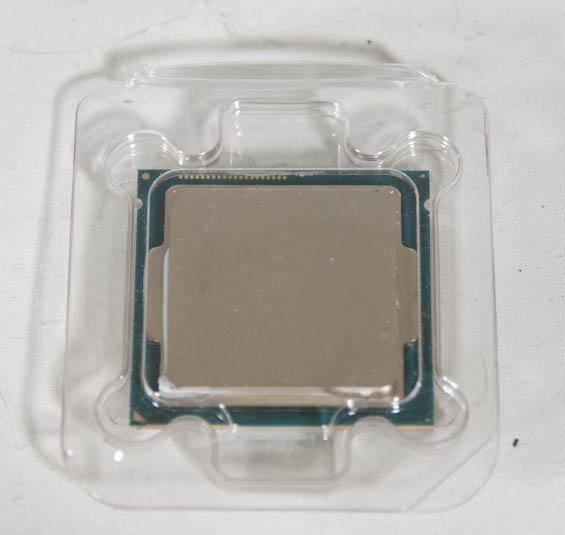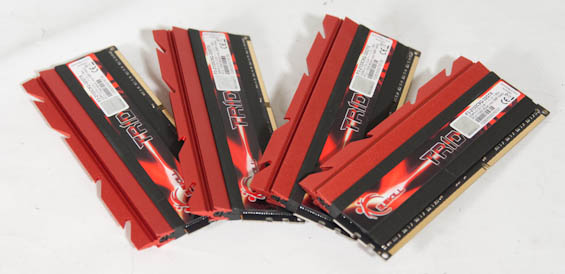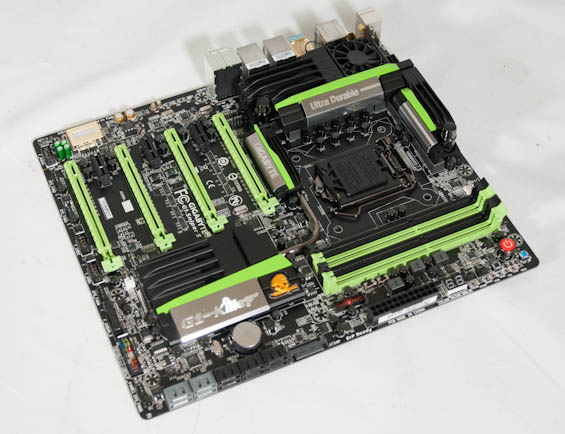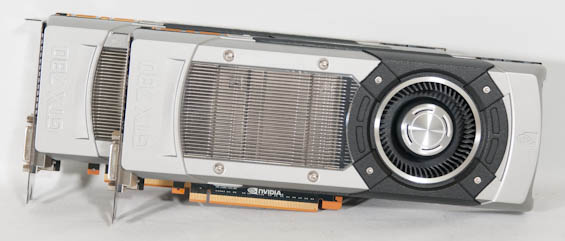The Neophyte's Custom Liquid Cooling Guide: How To, Why To, What To Expect
by Dustin Sklavos on September 30, 2013 12:01 AM ESTComponent selection for this build was tricky, but not overly so. If you're going to engage in an undertaking like this, you really do want to pick the most ideal hardware you can. Thankfully we had a few vendors willing to step up and donate some very high quality kit to this build.
Intel Core i7-4770K Processor

For our CPU we went with Intel's shiny new Haswell architecture in the form of the Core i7-4770K. This quad-core, hyper-threaded chip runs at a nominal 3.5GHz clock with a maximum turbo boost of 3.9GHz on a single core, and is one of Intel's first chips to feature an integrated VRM. Intel's 22nm chips seem to have been largely thermally limited, making the newest member of the family a compelling choice to be the center of a watercooling build. You do always run the risk of getting a dud CPU that simply doesn't want to run at a high clock speed without an unrealistic amount of voltage, though. Note that ours is a retail chip and not an Engineering Sample, so it's subject to the same potential limitations as any CPU you might pick up off the shelf.
Our thanks to CyberPowerPC for graciously donating this processor.
G.Skill Trident X 32GB (4x8GB) DDR3-2133 RAM

Our resident motherboard reviewer and overclocking expert, the good Dr. Ian Cutress, recommended we go with G.Skill for this build, and G.Skill was happy to oblige with a respectable kit of fast DDR3. This kit runs at a nominal 1600MHz, but features an XMP profile that sets it to run at 2133MHz with a CAS Latency of 9 at 1.6V. I'm not an aggressive memory overclocker, which makes the ready-out-of-the-box 2133MHz settings an easy way to score a little extra performance.
Our thanks to G.Skill for providing this memory.
Gigabyte G1.Sniper 5 Z87 Motherboard

I remain of the opinion that the Z87 chipset is arguably the most compelling part of Haswell, and Gigabyte's high end gaming offering hammers that home. The G1.Sniper 5 features a PLX switch enabling full PCIe 3.0 x16 lanes for each of two video cards, or PCIe 3.0 x8 for up to four. Alongside that are an additional four SATA 6Gbps ports to go along with the six that come with the Z87 chipset, dual gigabit ethernet NICs with one provided by Intel and the other courtesy of Killer Networks, and Creative Sound Core3D with a user upgradeable OP-AMP. There's even an 802.11n dual-band PCIe x1 wireless network adapter bundled with the motherboard.
But what sells this board for our purposes is that it includes not only active cooling on the motherboard's 16-phase power circuitry, but a liquid cooling path built in. There are barbs on both ends of the heatsink that allow you to include the power circuitry in your watercooling loop.
Our thanks to Gigabyte for providing this motherboard.
Dual NVIDIA GeForce GTX 780 Graphics Cards

With AMD currently still having issues with multi-GPU surround performance, we were left going to NVIDIA for a pair of high end graphics cards. Two GeForce GTX 770s would've been stellar on their own, but the 780 is getting a healthy reputation as being a decent overclocker in addition to just being a tremendously powerful card on its own. 7.1 billion transistors and 2,304 CUDA cores are nothing to sneeze at, and the 384-bit memory bus connected to 3GB of GDDR5 running at 6GHz stock ensures that beefy engine stays fed.
The biggest shame about using these reference 780s is actually having to remove their stock coolers. NVIDIA did a fantastic job engineering these shrouds, which are both very beautiful and very efficient.
Our thanks to NVIDIA for providing this pair of graphics cards.










106 Comments
View All Comments
meacupla - Tuesday, October 1, 2013 - link
The only thing this article proves is...1: corsair cube case can't mount enough radiators
2: poor radiator choices
ShieTar - Tuesday, October 1, 2013 - link
Yeah, despite the description by Corsair, this case is most certainly not designed to work well with water cooling. I mean, it has a 330mmx460mm foot print, that should be enough for 6x120mm or even 6x140mm radiators on top. Set it up like that, add 360mm worth of intake fans to the bottom front, and you will look at much more cooling power than the current solution.On the other hand, the air flow looks great for the air cooled solution, with the drive cages nicely out of the way. Thats probably hurting the comparison number in the above review, the fact that we compare a great air cooling case with a mediocre water cooling case.
HisDivineOrder - Tuesday, October 1, 2013 - link
"The last problem I ran into had to do with Swiftech's PWM splitter. While it's supposed to take the PWM signal from the motherboard and split it among all of the fans connected to it, the fans all wound up just running at full speed. It's tough to figure out exactly where the blame lies or if it's just an incompatibility. Honestly, I think a rig like this is pretty much the ideal situation for a Corsair Link kit, where extremely tight and flexible software control of multiple PWM channels is vital. Gigabyte has made a fantastic motherboard here in the G1.Sniper 5, but their fan control is still woefully lackluster."Sounds like you were trying to split a (supposed) PWM fan port other than your main CPU PWM port. On my P8Z77-V I had this brilliant idea to split the PWM fan ports I needed and let the motherboard run the rest, including the CPU separately. To let some fans go up and down more frequently than others.
Asus and other motherboard makers will tell you that all their 4 pin fan ports are PWM, but that's only half-true. Because they want them to be compatible with 3 pin fan control mechanisms, they are not true PWM controlled, so when you try to use a PWM splitter with them (all but that single 4 pin PWM fan port they have dedicated to CPU (and not the extra one either)), then they go full speed.
I had to wind up splitting all my fans off of just the main CPU 4 pin. This works, but it's not ideal because ALL my fans go up and down with what my CPU fan is doing. That's more noise than I'd like, but it's still less than the alternative.
All this to say, it's the motherboard maker's fault and you guys have been letting them get a free pass for years now on this. Perhaps you should start testing it and take them to task over it. I wouldn't blame the 8 pin splitter as I have it and it works fine.
The Von Matrices - Wednesday, October 2, 2013 - link
That's exactly what was true with my previous ASUS P6X58D Premium board. My new ASRock Z87-Extreme6 has only two PWM fam connectors, but both are wired correctly and are independently controlled. I agree that reviewers should test for this issue, but it seems that people who specifically want PWM fans are a minor component of the fan buying market and most will settle for 3-pin voltage controlled fans.mohamed Siran - Wednesday, October 2, 2013 - link
pls can you tel first photo corsair Case model ?Kathrine647 - Wednesday, October 2, 2013 - link
like Gregory said I am alarmed that a stay at home mom able to earn $5886 in 1 month on the internet. visit their website............B u z z 5 5 . com open the link without spacesdon_k - Friday, October 4, 2013 - link
"The reason is that watercooling necessitates using a water pump, and while they can be tuned down for efficiency, they're never going to be dead silent. An air cooler will always be a fan plus heatsink; watercooling adds a pump."Excellent article, very thorough, one thing though, I would beg to differ on this point. Pump noise rather obviously depends on the pump. The MCP35X that you chose, while a very good pump, is not the most silent. A D5 on the other hand can be completely, note not relatively but completely, silent when decoupled meaning not sitting or attached directly to the case so it does not cause vibrations on the case, even on its highest setting.
Similarly, how much fan noise you have depends on the fans you get and how fast you run them. The benefit with watercooling is you have a much larger surface area from which to dissipate heat, which gives you the option of several slow fans without sacrificing cooling capability.
Sure, you would get an few less points Celcius with higher RPMs but why bother when you're already at such a cool temperature and you need to double your fan speed and go from silent to noisy to do it.
To give you some concrete numbers from my own testing, a 3x120/140 radiator with a low FPI that is designed for low speed fans and 3 good quality fans at 700RPM is near silent. At 500RPM or less, completely silent. Pump noise is a non-issue, a D5 can be completely silent as I mentioned earlier.
Going from 500RPM to 1300RPM, the max on my fans, gives me a max of 5-7C decrease in water temperature under continuous load on both CPU and GPU, meaning running at 100% load for as long as necessary until temperatures stabilise at their maximum point.
Some watercoolers like to run high RPM fans and high FPI radiators so they can get really good temperatures at the expense of noise. Others do the opposite to get a silent system and still get better temps than on air. The choice is yours.
Shelbino - Monday, October 7, 2013 - link
Dustin, thanks very much for this article. I'm glad you supplied so much detail. My only big problem with the specific design here is the cost. I did a tally of the liquid cooling parts you used, and came up with a total of nearly one thousand dollars! IMHO, that's w-a-y too much for the relatively modest performance gains. Despite that, thanks for this detailed piece on liquid cooling.Volnaiskra - Friday, October 11, 2013 - link
So.......three days of work and hundreds of dollars for more noise, more power consumption, more maintenance, and about a 2% performance increase?I was seriously considering watercooling before, but you have thoroughly talked me out of it!!
expatswe - Saturday, October 12, 2013 - link
hmm, I liked the article and how the system was put together. Except I can not understand why it was so important to put the pump in the crammed space behind the powersupply when half the case was empty anyway.I was though really disappointed on how the over clocking was done and the results being shown. To me it looks like the writer ran out of steam and thus simply settled on the basic results on overclocking with liquid compared to air. It would be easy to get the system up to atleast 4.7GHz in that setup. I doubt it was the processor (which was given the blame)
30 db is the "noise" level in a quiet bedroom at night. 40db is a quiet library. Thus in the test it would be more interesting to know what the temperature levels seen on for example the water with CPU over clocked at different speeds without the GPU's being overclocked and then with one overclocked vs 2 overclocked to max level. Since the system was in series the water was effectively pre-heated before going into the GPU's. This is a common solution and since the article is written for beginners that is what would be interesting. Temperatures then also shown at no load vs full load at the relevant speeds would have been relevant.
This was not really a test of game speeds and software speeds as such but that of a build of cooling systems.